Assessing the costs of meeting Scotland's zero waste targets: report
Report examining the costs to local authorities of meeting the European Commission's Landfill Directive and Scottish Government Zero Waste targets.
4: Results
4.1 This chapter briefly outlines the scenarios looked at in the study, states the central assumptions made and then presents the results for each of the scenarios. A more detailed description of the scenarios, assumptions and method of analysis can be found in the methodology section.
Scenarios
4.2 To ascertain what infrastructure is required to meet future waste obligations and how much it will cost, Scotland's future municipal waste streams were forecast. This study modelled and considered six scenarios: these are summarised in Table 4.
Table 4-1 Municipal Solid Waste Forecast Scenarios
Scenario Number |
Description |
|---|---|
Scenario 1a. Do Nothing (With Landfill Fines) |
Continue at 2008/2009 levels of municipal waste processing and at present cost levels. No change in waste streams. The appropriate landfill fines are imposed. |
Scenario 1b. Do Nothing (No Landfill Fines) |
Continue at 2008/2009 levels of municipal waste processing and at present cost levels. No change in waste streams. No landfill fines are imposed. |
Scenario 2. EUWFD Only |
Meet all EU statutory obligations (only) such as the Waste Framework Directive and the Landfill Directive (e.g. landfill targets for 2010, 2013 and 2020; and 50% recycling/composting by 2020), but not the Scottish Government targets. |
Scenario 3. EUWFD & SG Targets (50/20) |
Meet all EU statutory obligations and all Scottish Government targets. This scenario assumes a 50/20 split between source segregation and residual waste to meet the 70% recycling and composting target. |
Scenario 4. EUWFD & SG targets (60/10) |
Meet all EU statutory obligations and all Scottish Government targets as per scenario 3 except this scenario assumes a 60/10 split between source segregation and residual waste to meet the 70% recycling and composting target. |
Scenario 5. EUWFD & SG Targets (65/5) |
Meet all EU statutory obligations and all Scottish Government targets as per scenario 3 except this scenario assumes a 65/5 split between source segregation and residual waste to meet the 70% recycling and composting target. |
Scenario 6. EfW cap by 2018 |
Meet all EU statutory obligations and all Scottish Government targets as in scenario 3 except that EfW reaches its 25% cap sooner in 2018. |
Source: SQW Energy
4.3 Scenario 1a and 1b presents the 'Do Nothing' option as a datum to illustrate the implications of continuing in a 'business as usual' manner with no change in procedure or to the costs of dealing with municipal waste. Scenario 1a includes any landfill fines imposed for missing targets, while Scenario 1b does not take into account landfill fines. Scenario 2 highlights the minimum required to comply with EU statutory obligations and avoid any penalties. Scenario 3 demonstrates what is needed to meet all EU statutory obligations and achieve the targets set down by the Scottish Government. Scenarios 4, 5 and 6 show variations on Scenario 3.
4.4 The annual net cost of collecting and processing all the municipal waste in Scotland according to the most recent publicly available data (2007/2008) is £404 million 34. This study modelled Scotland's future waste management requirements to assess the financial impacts above existing spending levels under the six scenarios through to 2025.
4.5 Detailed costs and benefits of implementing the six MSW scenarios were then evaluated in line with the approach recommended in the HM Treasury Green Book 35. This included the capital cost of new infrastructure; the cost of collecting; processing; penalties and the benefits arising from processed waste (e.g. recyclate revenue, generated electricity, etc).
4.6 The costs and benefits for each scenario are set out in a table representing the totals from 2010 to 2025. This includes the Net Present Cost which equates to the balance of costs to benefits (or overall financial impact) of that scenario over and above current funding levels to 2025.
Assumptions
4.7 The main assumptions made for all the scenarios were as follows:
- Only Municipal Solid Waste was considered.
- No growth in total Municipal Solid Waste arising beyond 2010.
- 2:1 split for recycling to composting to meet the recycling and composting targets.
- No more than 25% of total waste arising goes to EfW.
4.8 Following consultations with local authorities, it was forecast that Total Waste Arisings ( TWA) would fall until 2010. For the purposes of this study, it was assumed that TWA would remain flat beyond 2010.
Results
4.9 This section reports the results for each of the scenarios in turn.
Scenario 1a & b - Do Nothing
4.10 Figure 4-1 (a) shows the theoretical forecasted MSW streams to 2025 if there was a 'Do Nothing' approach and waste streams continued at current levels. Although this scenario corresponds to unlikely conditions (waste streams and processes will undoubtedly change over time), it is presented to give a datum against which other scenarios can be compared.
Figure 4-1 (a) MSW Forecast Scenario 1 a and b - Do Nothing
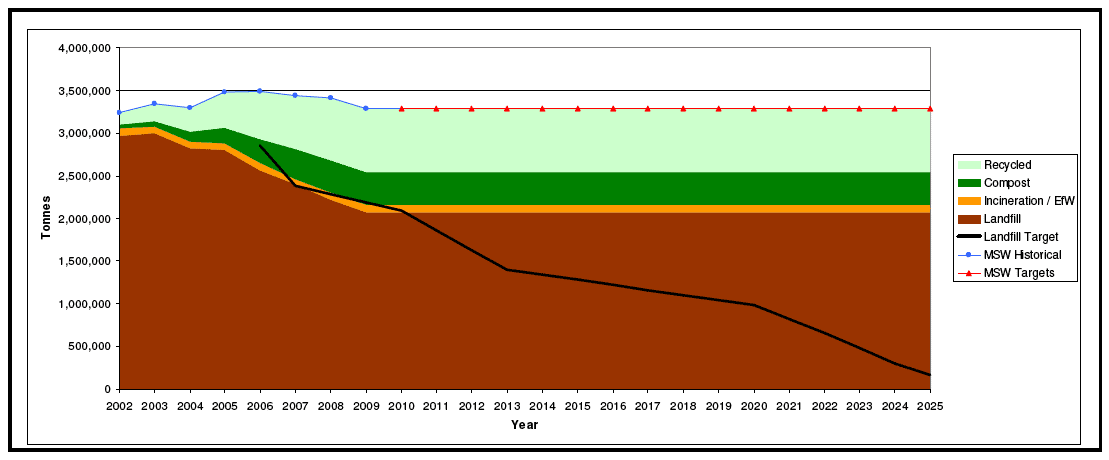
Source: SQW Energy
4.11 Before carrying out the Cost Benefit Analysis of the "Do Nothing" scenario, it is worth setting the context using current levels of spending. The cost of collecting and processing all the municipal waste in Scotland according to the most recent publicly available data (2007/2008) is £404 million 36. Ignoring inflation and all other factors for a moment, if there is no further infrastructure investment and there are no changes in waste management practice in any year until 2025, this would give a theoretical nominal operational cost for municipal waste management sustained at current levels to 2025 of £6,464 million. Although a crude calculation, this gives an indication (in the most simple terms) of the scale of funding required by simply continuing the status quo.
4.12 In addition to the £404 million operational costs spent in 2007/2008, £42 million37 of capital was invested in new infrastructure. Using this information, a full Cost Benefit Analysis of Scenario 1a and b "Do Nothing" was modelled to assess the financial impacts over and above the existing spending levels.
4.13 Table 4-2 shows the costs and benefits of Scenario 1a and b "Do Nothing" to 2025:
Table 4-2 Scenario 1a and b "Do Nothing" Cost Benefit Analysis 2010 to 2025 (all figures NPV)
Cost / Benefit Category |
1a) with Fines |
1b) no Fines |
|---|---|---|
Collection Costs |
£2,480 |
£2,480 |
Processing Costs |
£4,115 |
£4,115 |
(of which Landfill Costs) |
£3,597 |
£3.597 |
Landfill Fines |
£1,288 |
0 |
Infrastructure Costs |
£91 |
£91 |
Benefits |
£559 |
£559 |
Total Net Present Costs |
£7,415 |
£6,127 |
Net Present Cost (over and above current spending levels to 2025) |
£2,346 |
£1,058 |
Source: SQW Energy
4.14 It can be seen from Table 4-1 that Scenario 1a "Do Nothing with Landfill Fines" would cost an additional £2,346 million from 2010 to 2025 over and above that of existing spending levels. This is primarily due to the significant Landfill Fines which would total £1,288 million NPV. With the landfill fines removed, the cost of Scenario 1b is substantially less at £1,058 NPV over the time period.
4.15 The main drivers of costs are those of collection and processing. Infrastructure costs are modest with only £91 million being required over the period. This reflects the "Do Nothing" premise of the scenario and acknowledges that in 2007/2008 spending also included some investment in new technology. In effect the annual investment in new technology would replace aging infrastructure or be invested to improve efficiency.
4.16 The levels of market benefits are modest in comparison to costs with £559 million benefits over the period, primarily from the generation of electricity from landfill and the sale of recyclate. (n.b. the value of ROCs has been excluded as this is considered a subsidy at national level. Details of the benefits with ROCs are provided in Annex B.)
4.17 Figure 4-1(b) illustrates the capacity for additional infrastructure required and the year by which it must be operational to continue in a 'business as usual fashion'. This is the same for both Scenario 1a and 1b.
Figure 4-1(b) Infrastructure Capacity Requirement for "Do Nothing" (Scenario 1)
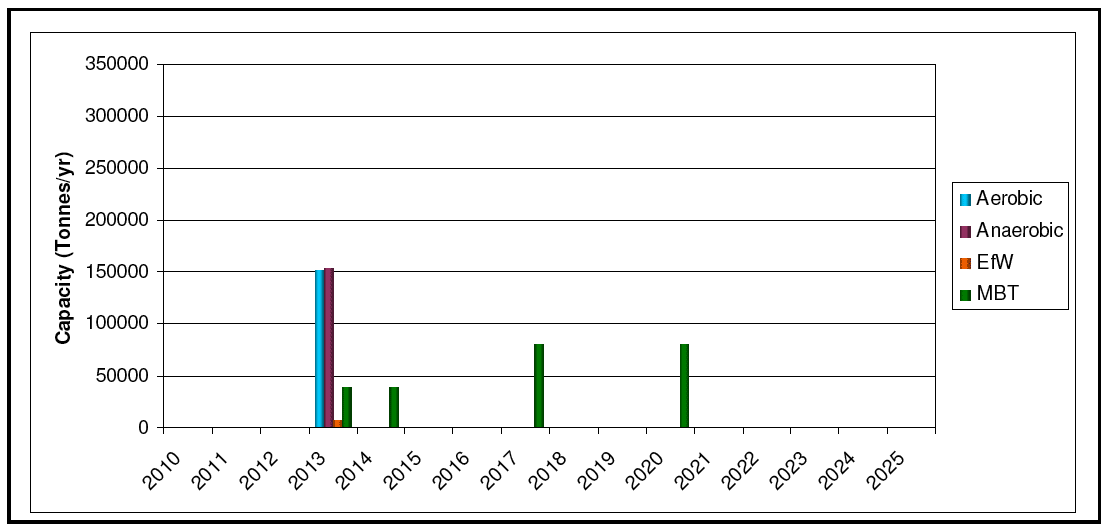
Source: SQW Energy
4.18 To be consistent, the same assumptions relating to how waste is handled are applied to the "Do Nothing" scenario as other scenarios. Where waste streams exceed estimated existing capacity over the study period, it is assumed that the local authorities will put in place infrastructure to accommodate this. This is consistent with the 'business as usual' principle of Scenario 1 since there is currently capital expenditure made on new infrastructure each year. In addition, there is a time mismatch in the data for existing capacity (2007) and waste levels (2009). The difference in time explains the immediate need for capacity in 2013, particularly composting, some of which may already have been installed in the interim.
Scenario 1 Conclusion
4.19 To "Do Nothing" may require the least in terms of infrastructure costs, but the landfill fines and the impact on the environment make it an expensive option. Even without the landfill fines, scenario 1b is not the most cost efficient of the scenarios analysed.
Scenario 2 - Meet EU Obligations Only
4.20 Figure 4-2(a) shows the forecasted MSW streams to 2025 to meet the EU statutory obligations (only) such as the Waste Framework Directive and the Landfill Directive (i.e. landfill targets for 2010, 2013 and 2020; and 50% recycling/composting by 2020), but not the Scottish Government targets. In effect, to do just enough to avoid EU penalties and infractions.
Figure 4-2(a) MSW Forecast Scenario 2 - Meet EU Obligations Only
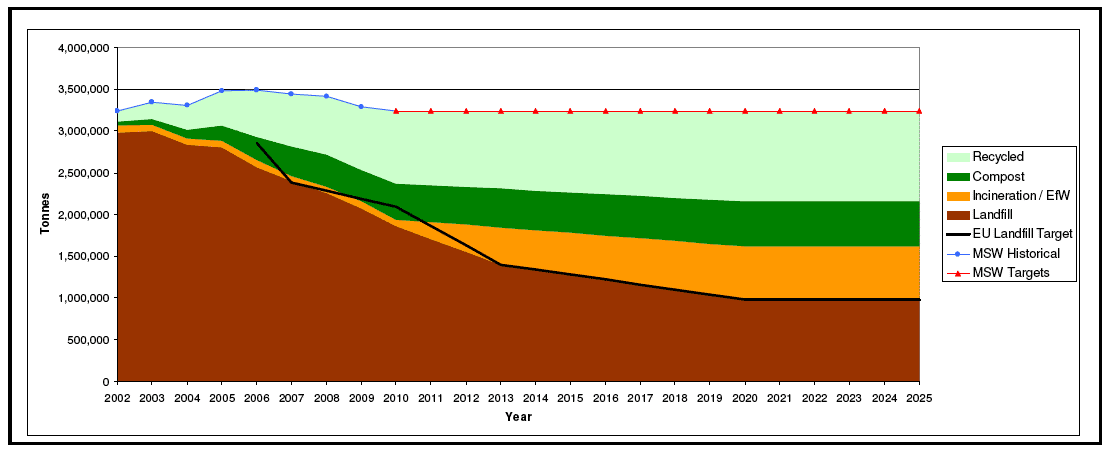
Source: SQW Energy
4.21 It can be seen in Figure 4-2 that the EU targets require a significant reduction in the amount of waste sent to landfill compared to historical levels. In addition, significant increases in recycling and composting are required to achieve the obligations set under the Waste Framework Directive.
4.22 Table 4-3 shows the costs and benefits to 2025 of Scenario 2 "Meet EU Obligations Only":
Table 4-3 Scenario 2 "Meet EU Obligations Only" Cost Benefit Analysis 2010 to 2025 (all figures NPV)
Cost / Benefit Category |
(millions) |
|---|---|
Collection Costs |
£3,347 |
Processing Costs |
£3,431 |
(of which Landfill Costs) |
£2,059 |
Landfill Fines |
0 |
Infrastructure Costs |
£434 |
Benefits |
£697 |
Total Net Present Costs |
£6,514 |
Net Present Cost (over and above current spending levels to 2025) |
£1,445 |
Source: SQW Energy
4.23 It can be seen from Table 4-3 that Scenario 2 "Meet EU Obligations Only" would cost an additional £1,445 million over and above existing spending levels from 2010 to 2025. Although the collection and processing costs are higher than scenario 1, the avoidance of landfill fines makes Scenario 2 significantly cheaper than scenario 1a, but more expensive than scenario 1b.
4.24 Infrastructure Costs are significantly higher than those of Scenario 1. This is due to the investment in new technology required to achieve the waste stream levels needed to meet EU targets.
4.25 The benefits have also increased compared to Scenario 1. The benefits are still mostly due to landfill electricity generation (excluding ROCs) and recyclate sales in equal measure.
4.26 Figure 4-2(b) illustrates the capacity for additional infrastructure required and the year by which it must be operational to meet the EU obligations as outlined in Scenario 2.
Figure 4-2(b) Infrastructure Capacity Requirement to meet EU Obligations Only (Scenario 2)
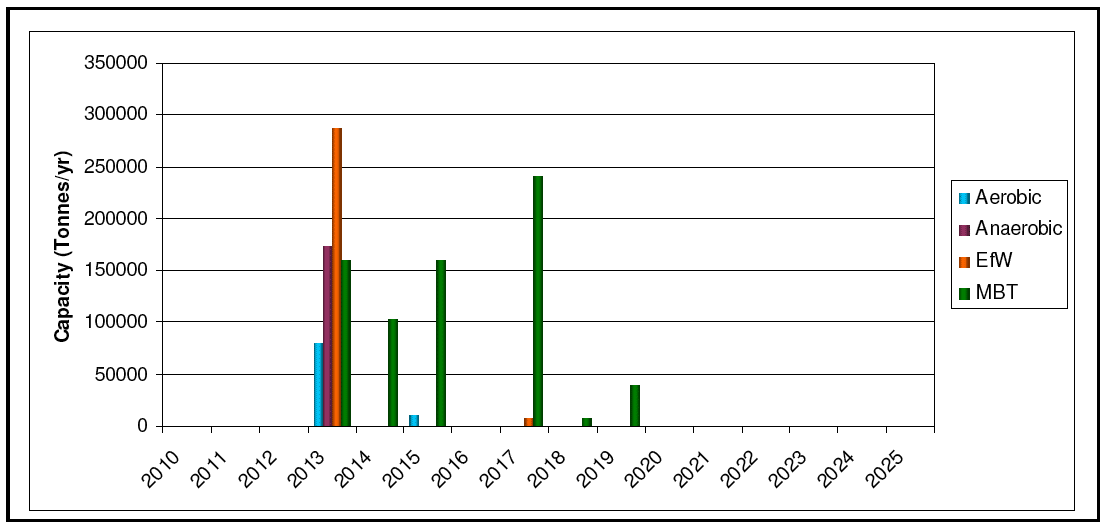
Source: SQW Energy
4.27 It can be seen that there is a significant requirement for additional infrastructure to be operational by the year 2013. Assuming a minimum two to three year lead time for most infrastructure projects, steps must be taken now if the 2013 targets are to be met.
4.28 The EU target for 50% recycling and composting is not applicable until 2020 and Scotland is already on target to meet its recycling target of 40% by 2010 target. With ten years to go until the 2020 EU target needs to be achieved, the EU recycling and composting target is not the main driver in this scenario. The main driver is the landfill directive. As such, the largest and most immediate requirement is for EfW plants that will be required to take the waste diverted from landfill to achieve the landfill objective. There is also a requirement for MBT infrastructure in 2010, primarily to produce feedstock for the EfW plants, but also to produce recyclate.
4.29 Also required in 2010 is anaerobic composting to process food waste that is diverted from landfill. Some additional aerobic capacity will also be required to cope with the increase levels of composting.
4.30 Beyond 2010, the requirement is primarily for MBT. This is due to a continued requirement to produce feedstock for the EfW capacity and also to help achieve the additional recycling levels required.
Scenario 2 Conclusion
4.31 To meet only the EU obligations will require significant investment in infrastructure, particularly EfW and MBT. The avoidance of landfill fines makes it a cheaper option than the Do Nothing with Landfill Fines, however, there is a significant 'infrastructure hurdle' to clear in 2013 if targets are to be met.
Scenario 3 - Meet all EU and Scottish Government Targets (50/20 split)
4.32 Figure 4-3(a) shows the forecasted MSW streams to 2025 that are required to meet all EU statutory obligations and Scottish Government targets. In this scenario it is assumed that the 70% target for recycling and composting will compose of a 50/20 split between source segregation (50) and residual treatment (20).
Figure 4-3(a) MSW Forecast Scenario 3 - Achieve all EU Obligations and Scottish Government Targets (50/20 split)
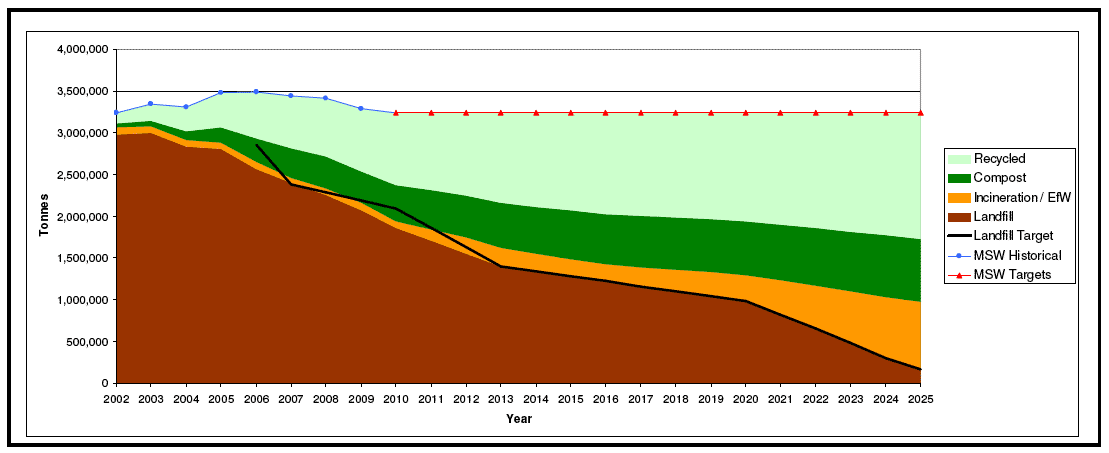
Source: SQW Energy
4.33 It can be seen from Figure 4-3(a) that the targets set down by the Scottish Government present a more ambitious challenge for Scotland's waste management sector.
4.34 To meet all targets and obligations (Scenario 3), each waste stream forecast to 2025 is effectively determined by the order of precedence in which the targets must be achieved. The EU landfill targets must be met first as they are legally binding and limit the absolute quantity of biodegradable municipal waste sent to landfill. Following this, the targets for recycling and composting must be achieved and these are expressed as a percentage of the total municipal waste arising. The goal of no growth beyond 2010 of the total municipal waste arising puts an upper limit on future forecasts.
4.35 This leaves the EfW waste stream. The maximum that can go to EfW is the waste that remains once the other targets are satisfied. In Scenario 3, EfW does not reach its cap of 25% until 2025. In effect, if the national targets are to be met exactly (no more, no less), the sizes of Scotland's municipal waste streams to 2025 are pre-defined by the targets.
4.36 Table 4-4 shows the costs and benefits to 2025 of Scenario 3 "Meet all EU and Scottish Government Targets (50/20 split)":
Table 4-4 Scenario 3 "Meet all EU and Scottish Government Targets (50/20 split)
Cost Benefit Analysis 2010 to 2025 (all figures NPV)
Cost / Benefit Category |
(millions) |
|---|---|
Collection Costs |
£3,763 |
Processing Costs |
£3,006 |
(of which Landfill Costs) |
£1,815 |
Landfill Fines |
0 |
Infrastructure Costs |
£449 |
Benefits |
£682 |
Total Net Present Costs |
£6,536 |
Net Present Cost (over and above current spending levels to 2025) |
£1,467 |
Source: SQW Energy
4.37 At a Net Present Cost of £1,467 million over and above current spending to 2025, it is only marginally more expensive to achieve the Scottish Government targets than it is to meet the EU targets only.
4.38 Although collection costs are significantly higher because of the more ambitious recycling and composting targets set by the Scottish Government, the processing costs are reduced because of the reduced EfW and landfill processing costs, i.e. Scotland would recycle and compost more waste rather than burn and landfill.
4.39 To meet the additional Scottish Government targets, infrastructure costs are £15 million higher than meeting the EU obligations only.
4.40 Figure 4-3(b) illustrates the capacity of additional infrastructure required and the year by which it must be operational to meet all EU and Scottish Government waste management targets with a 50/20 split.
Figure 4-3(b) Infrastructure Capacity Requirement to meet all EU & Scottish Government Targets with 50/20 split (Scenario 3)
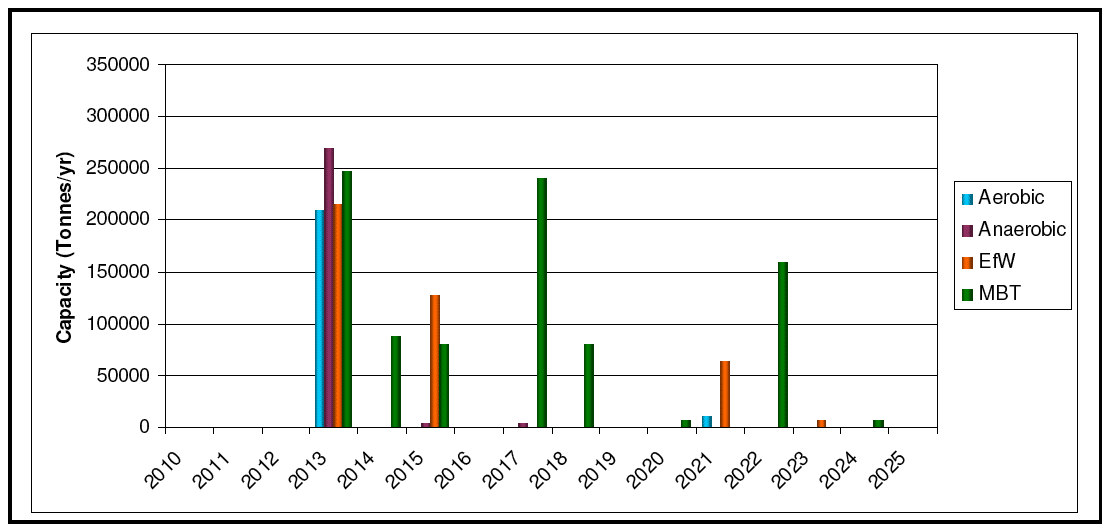
Source: SQW Energy
4.41 It can be seen that there is a significant requirement for additional infrastructure to be operational by the year 2013. Assuming a minimum two to three year lead time for most infrastructure projects, steps must be taken now if the 2013 targets are to be met.
4.42 Although all four technologies analysed require similar capacities to be operational by 2013, both EfW and MBT, will require additional capacity to be commissioned between 2013 and 2025.
4.43 There is a growing requirement for MBT infrastructure, chiefly composed of medium and large units, as source segregation approaches its maximum capture rates (for Scenario 3 -assumed to be 50% of Total Waste Arising) and as demand for EfW feedstock comes on stream.
4.44 Once the appropriate capacity of Aerobic and Anaerobic infrastructure is commissioned by 2013, there is little requirement for additional composting infrastructure to meet composting targets to 2025.
Scenario 3 Conclusion
4.45 To achieve the more ambitious Scottish Government targets over and above the EU obligations, the marginal cost is relatively small; particularly when considering the significant gains that would be made in waste management, i.e. for a little extra investment, we achieve disproportionally higher results.
Scenario 4 - Meet all EU and Scottish Government Targets (60/10 split)
4.46 Figure 4-4(a) shows the forecasted MSW streams to 2025 that are required to meet all EU statutory obligations and Scottish Government targets. In this scenario it is assumed that the 70% target for recycling and composting will compose of a 60/10 split between source segregation (60) and residual treatment (10).
Figure 4-4(a) MSW Forecast Scenario 4 - Achieve all EU Obligations and Scottish Government Targets (60/10 split)
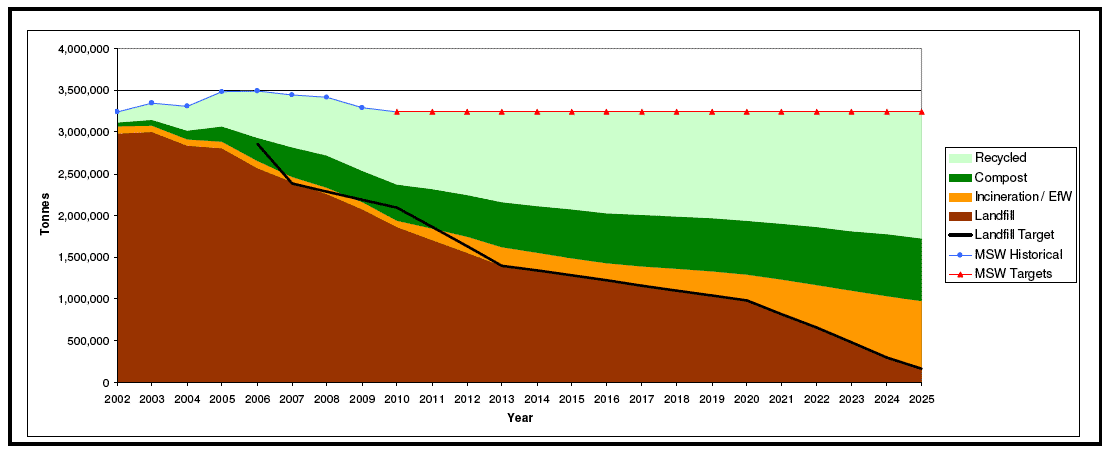
Source: SQW Energy
4.47 The only difference between Scenario 4 and the previous one is that in this scenario, 60% of TWA will be source segregated for use in recycling or composting while the remainder (10% of TWA) can be obtained through residual treatments. This has the effect of delaying the need for MBTs.
4.48 Table 4-5 shows the costs and benefits to 2025 of Scenario 4 "Meet all EU and Scottish Government Targets (60/10 split)":
Table 4-5 Scenario 4 "Meet all EU and Scottish Government Targets (60/10 split)
Cost Benefit Analysis 2010 to 2025 (all figures NPV)
Cost / Benefit Category |
(millions) |
|---|---|
Collection Costs |
£3,724 |
Processing Costs |
£2,888 |
(of which Landfill Costs) |
£1,815 |
Landfill Fines |
0 |
Infrastructure Costs |
£342 |
Benefits |
£682 |
Total Net Present Costs |
£6,271 |
Net Present Cost (over and above current spending levels to 2025) |
£1,203 |
Source: SQW Energy
4.49 The Net Present Cost over and above current spending levels to 2025 of Scenario 4 is £1,203. This is less than the equivalent scenario 3 with the 50/20 split due mainly to a combination of reduced infrastructure required to process residual waste and less processing costs. Processing costs are reduced by gaining efficiencies from current collection infrastructure and increasing source segregation; hence processing costs are shifted towards the waste producer rather than centralised MBT units.
4.50 Infrastructure costs are reduced as there is less need for plant to carry out residual treatment.
4.51 Figure 4-4(b) illustrates the capacity of additional infrastructure required and the year by which it must be operational to meet all EU and Scottish Government waste management targets with a 60/10 split.
Figure 4-4(b) Infrastructure Capacity Requirement to meet all EU & Scottish Government Targets with 60/10 split (Scenario 4)
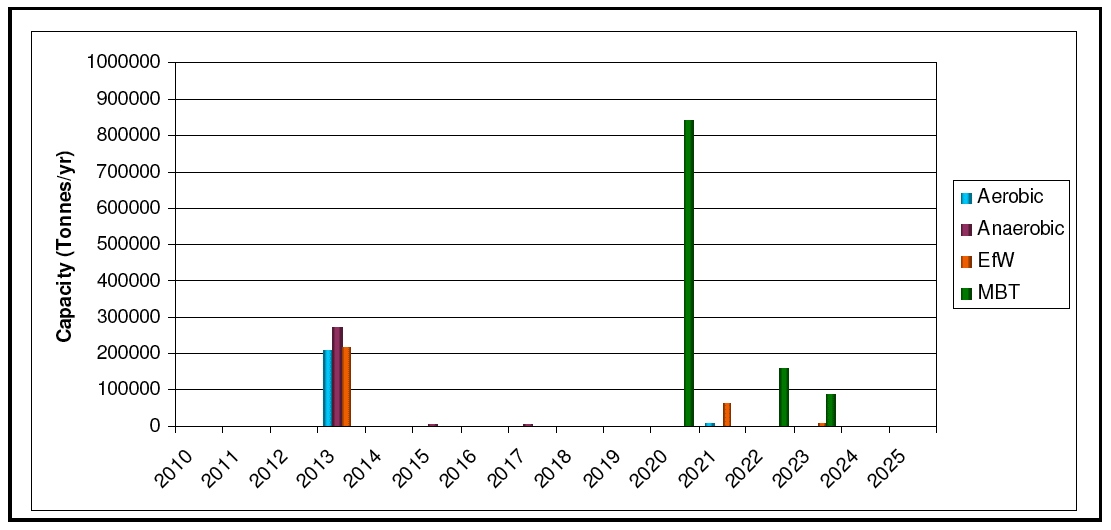
Source: SQW Energy
4.52 It can be seen that the need for infrastructure investment by 2013 is similar to scenario 3 for aerobic, anaerobic and EfW. However, the requirement for MBT is reduced and delayed by increasing the levels of source segregation. In effect, by continuing to improve the capture rates of current source segregation infrastructure, costs are shifted towards the waste producer rather than a centralised MBT unit.
4.53 There is a requirement for significant MBT capacity in 2020 as source segregation approaches its maximum capture rate assumption (for Scenario 4 -assumed to be 60% of Total Waste Arising).
Scenario 4 Conclusion
4.54 Increased source segregation reduces the cost of meeting EU and Scottish Government targets. Infrastructure investment is also reduced as there is less need for large centralised MBT plants for residual treatment.
Scenario 5 - Meet all EU and Scottish Government Targets (65/5 split)
4.55 Figure 4-5(a) shows the forecasted MSW streams to 2025 that are required to meet all EU statutory obligations and Scottish Government targets. In this scenario it is assumed that the 70% target for recycling and composting will compose of a 65/5 split between source segregation (65) and residual treatment (5).
Figure 4-5(a) MSW Forecast Scenario 5 - Achieve all EU Obligations and Scottish Government Targets (65/5 split)
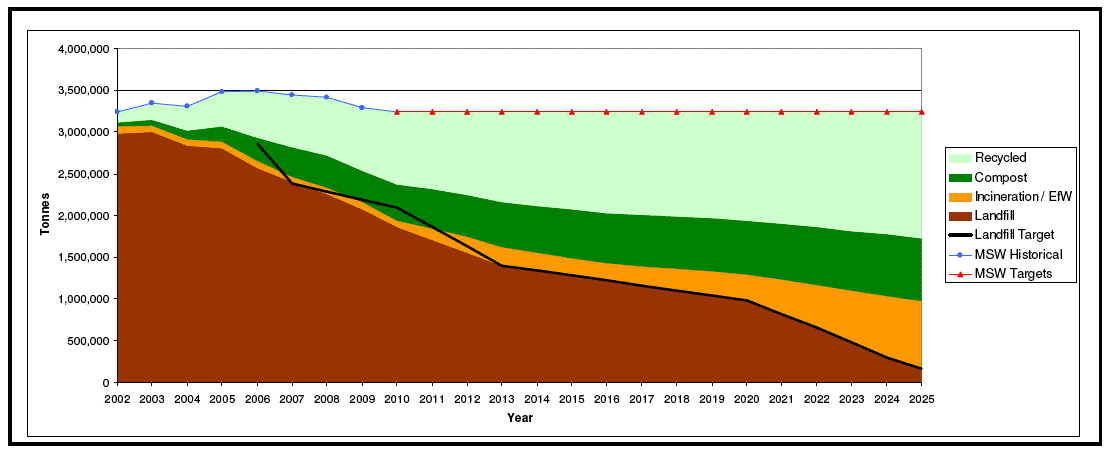
Source: SQW Energy
4.56 In this scenario, 65% of TWA will be source segregated for use in recycling or composting while the remainder (5% of TWA) can be obtained through residual treatments. This has the effect of delaying the need for MBTs.
4.57 Table 4-6 shows the costs and benefits to 2025 of Scenario 5 "Meet all EU and Scottish Government Targets (65/5 split)":
Table 4-6 Scenario 5 "Meet all EU and Scottish Government Targets (65/5 split)
Cost Benefit Analysis 2010 to 2025 (all figures NPV)
Cost / Benefit Category |
(millions) |
|---|---|
Collection Costs |
£3,695 |
Processing Costs |
£2,799 |
(of which Landfill Costs) |
£1,815 |
Landfill Fines |
0 |
Infrastructure Costs |
£303 |
Benefits |
£682 |
Total Net Present Costs |
£6,114 |
Net Present Cost (over and above current spending levels to 2025) |
£1,046 |
Source: SQW Energy
4.58 The Net Present Cost over and above current spending levels to 2025 of Scenario 5 is £1,046. This makes it the least expensive of all the scenarios that were modelled. Again, this is due to a combination of reduced infrastructure required to process residual waste and less processing costs. Processing costs are reduced by gaining efficiencies from current collection infrastructure and increasing source segregation; hence processing costs are shifted towards the waste producer rather than centralised MBT units.
4.59 Infrastructure costs are reduced as there is less need for plant to carry out residual treatment.
4.60 Figure 4-5(b) illustrates the capacity of additional infrastructure required and the year by which it must be operational to meet all EU and Scottish Government waste management targets with a 65/5 split.
Figure 4-5(b) Infrastructure Capacity Requirement to meet all EU & Scottish Government Targets with 65/5 split (Scenario 5)
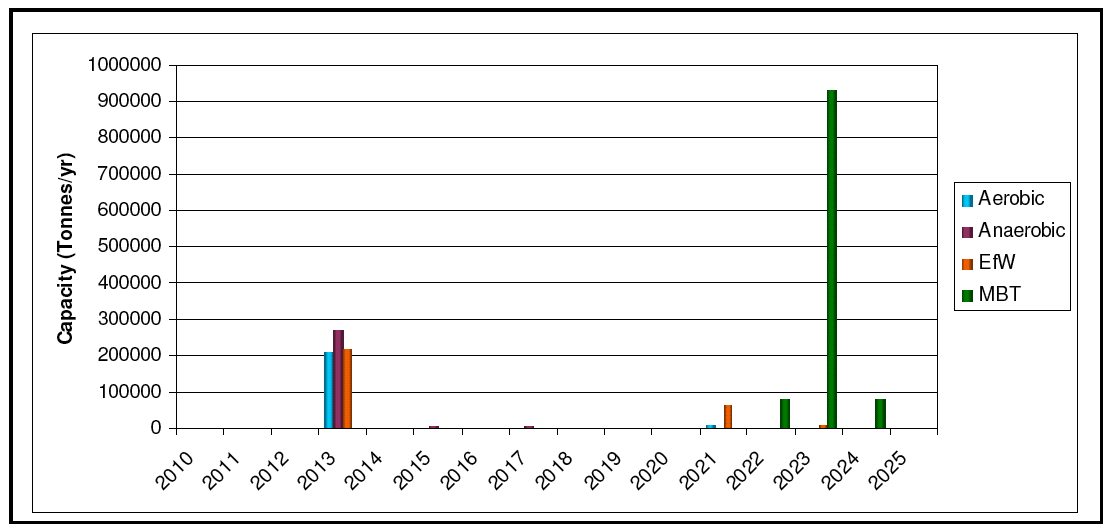
Source: SQW Energy
4.61 It can be seen that the need for infrastructure investment by 2013 is similar to scenario 3 and 4 for aerobic, anaerobic and EfW. However, the requirement for MBT is further delayed. In effect, by continuing to improve the capture rates of current source segregation infrastructure, costs are shifted towards the point of waste collection rather than a centralised MBT unit.
4.62 There is a requirement for significant MBT capacity in 2023 as source segregation approaches its maximum capture rates (for Scenario 5 -assumed to be 65% of Total Waste Arising). The capacity of MBT required, although delayed, is still relatively high. This is due to the fact that many WSAs will need an MBT, but it may not be as heavily utilised. In this case it may be more efficient for WSAs to combine their MBT requirements.
Scenario 5 Conclusion
4.63 Increased source segregation reduces the cost of meeting EU and Scottish Government targets. Scenario 5 produced the lowest cost method of meeting all EU and Scottish Government targets.
Scenario 6 - Meet all EU and Scottish Government targets with EfW reaching its 25% cap earlier in 2018
4.64 Figure 4-6(a) shows the forecasted MSW streams to 2025 that are required to meet all EU statutory obligations and Scottish Government targets. In this scenario, EfW capacity is commissioned earlier and waste is diverted from landfill to the EfW plant. Source segregation to residual split is 50/20 as in scenario 3.
Figure 4-6(a) MSW Forecast Scenario 6 - Achieve all EU Obligations and Scottish Government Targets with EfW reaching its 25% cap in 2018
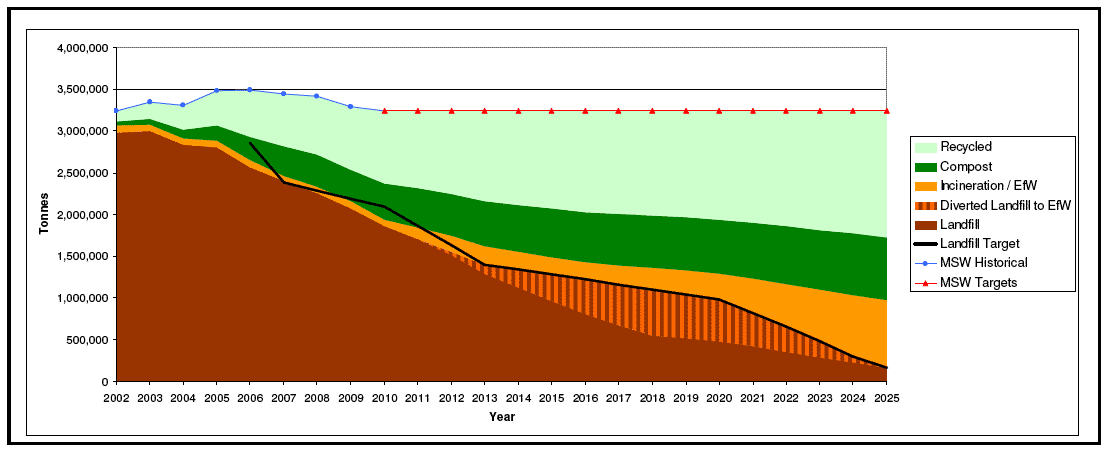
Source: SQW Energy
4.65 It can be seen that by bringing EfW online earlier, waste is diverted from landfill and the landfill targets are exceeded. However, it is worth noting that to achieve the recycling and composting targets, all the additional waste for EfW must come from landfill. If any waste is diverted from recycling or composting, then these targets will be missed.
4.66 Table 4-7 shows the costs and benefits to 2025 of Scenario 6 "Meet all EU and Scottish Government Targets with EfW reaching its 25% cap earlier in 2018":
Table 4-7 Scenario 6 "Meet all EU and Scottish Government Targets with EfW reaching its 25% cap earlier in 2018"
Cost Benefit Analysis 2010 to 2025 (all figures NPV)
Cost / Benefit Category |
(millions) |
|---|---|
Collection Costs |
£3,811 |
Processing Costs |
£2,981 |
(of which Landfill Costs) |
£1,397 |
Landfill Fines |
0 |
Infrastructure Costs |
£646 |
Benefits |
£741 |
Total Net Present Costs |
£6,697 |
Net Present Cost (over and above current spending levels to 2025) |
£1,628 |
Source: SQW Energy
4.67 The Net Present Cost over and above current spending levels to 2025 of Scenario 6 is £1,628. This makes it more expensive than all the scenarios apart from Scenario 1a "Do Nothing with Landfill Fines". This is due to the increase in collection, processing and infrastructure costs associated with bringing the EfW capacity sooner.
4.68 Infrastructure costs are increased as more EfW plant is brought online sooner, making Scenario 6 the most expensive in terms of infrastructure investment alone.
4.69 Scenario 6 gives the biggest return in benefits of any scenario. However the increase in benefits is more than offset by the increase in costs. (n.b. the value of ROCs has been excluded as this is considered a subsidy from government.)
4.70 Figure 4-6(b) illustrates the capacity of additional infrastructure required and the year by which it must be operational to meet all EU and Scottish Government waste management targets with EfW reaching its 25% cap by 2018.
Figure 4-6(b) Infrastructure Capacity Requirement to meet all EU & Scottish Government Targets with EfW reaching its 25% cap by 2018 (Scenario 6)
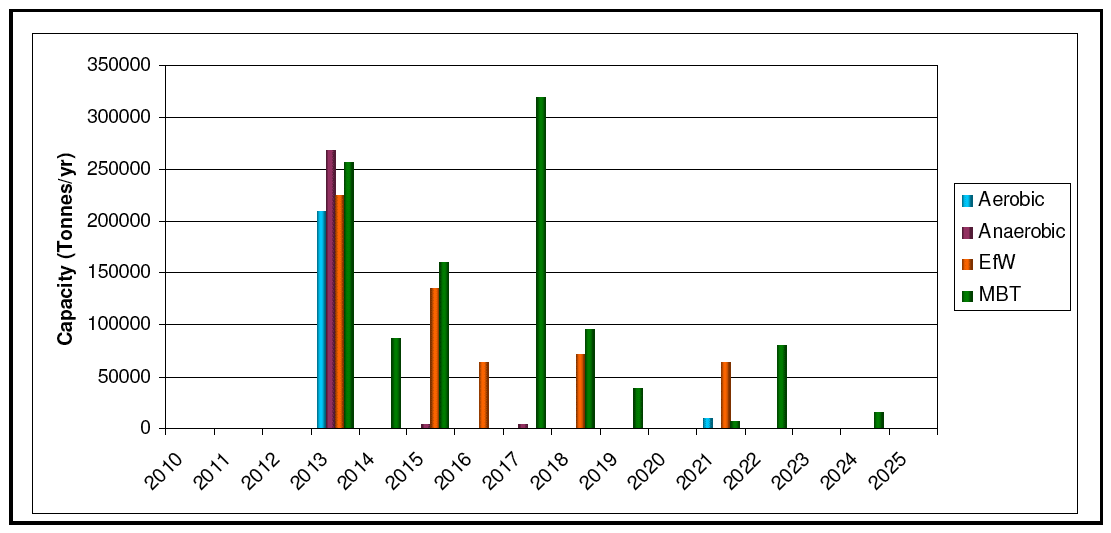
Source: SQW Energy
4.71 It can be seen that the need for infrastructure investment by 2013 is similar to scenario 3. However, there is additional requirement for EfW and MBT in subsequent years to deal with the increased levels of EfW waste as it reaches its 25% cap by 2018.
4.72 The additional MBT infrastructure is required to produce the feedstock for the EfW plants.
Scenario 6 Conclusion
4.73 By bringing EfW plant on earlier, there is also an increased need for MBT, which in turn drives up processing and infrastructure costs. Although there are additional benefits in this scenario, these are more than offset by the increased costs, making scenario 6 the most expansive scenario after Scenario 1a "Do Nothing with Landfill Fines". By accelerating EfW installation, the result may be to increase competition between EfW and recycling and composting, which may in turn jeopardise recycling and composting targets.
Annual Nominal Additional Cost
4.74 Figure 4.7 shows the additional costs annually of each scenario, on a nominal basis. It illustrates that the timing of expenditure is very different between scenarios and is important in terms of overall cost efficiency. It can be seen that although Scenario 5 costs considerably more after 2022, the Net Present Cost of Scenario 5 has the lowest NPV because the major expenditure is delayed until later years. For this reason, Scenario 5 is more cost efficient than all other scenarios, including Scenario 1B (Do Nothing - without Landfill Fines). A table of the graph data can be found in Appendix B.14
Figure 4.7 - Additional Costs in Excess of Existing Expenditure (Nominal)
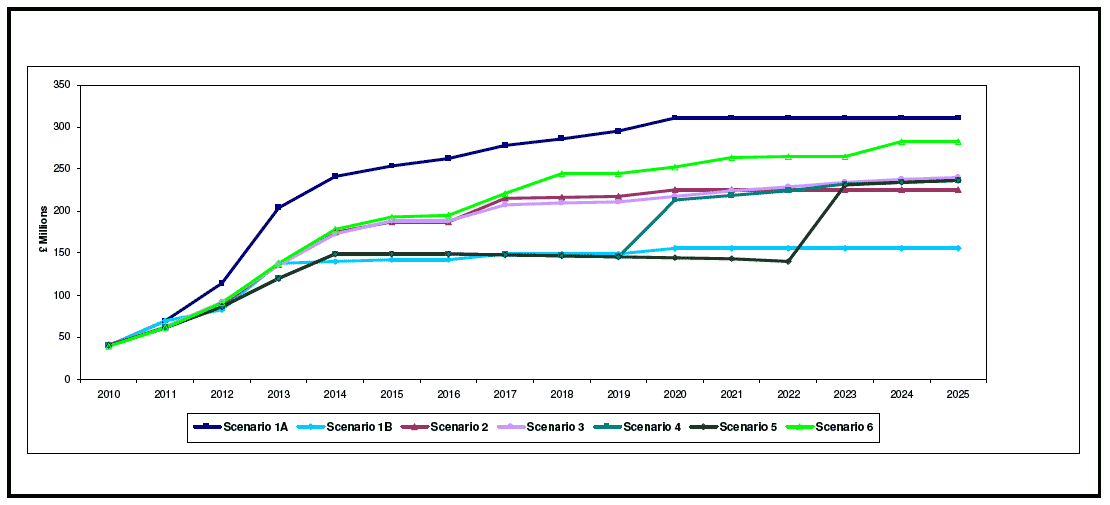
Source: SQW Energy
Results Summary
4.75 Although progress to date has been encouraging, the advances made so far will most likely prove to be the easiest steps on the road to a Zero Waste society as the more straightforward gains are achieved first. Consequently, future municipal waste management will prove more challenging and require further changes in our approach to waste management. Existing infrastructure capacity will be insufficient to meet these targets through to 2025.
4.76 It can be seen that there is a significant requirement for additional infrastructure to be operational by the year 2013 although the imperative is not as great for scenarios 4 and 5. Some waste management technologies will prove more challenging to bring online than others, e.g. MBT and AD will prove more challenging than EfW plants from a technology point of view, however the opposite may be true from a planning standpoint. EfW may be chosen as the easier short-term solution, when in fact it may have the effect of exacerbating the waste management difficulties in the future through competition with recycling and composting. Assuming a minimum two to three year lead time for most infrastructure projects, steps must be taken now if the 'waste target hurdle' of 2013 is to be cleared.
4.77 Increased levels of source segregation significantly reduce the amount of new infrastructure required and the processing costs. The 60/10 and 65/5 split of Scenario 4 and 5 both delay the need for infrastructure, particularly MBT, and allow more time for appropriate planning.
4.78 Once the appropriate capacity of Aerobic and Anaerobic infrastructure is commissioned by 2013, there is little requirement for additional composting infrastructure to meet composting targets to 2025 in any of the scenarios.
Cost Benefit Analysis
4.79 Table 4-8 shows the Cost Benefit Analysis figures for all the scenarios.
Table 4-8 - Cost Benefit Analysis (2010 to 2025)
Scenario |
Collection |
Processing |
Landfill Fines |
Infrastr. Investment |
Benefits |
Total Net Present Cost |
Net Present |
|---|---|---|---|---|---|---|---|
1a. Do Nothing (with Fines) |
£2,480 |
£4,115 |
£1,288 |
£91 |
£559 |
£7,415 |
£2,346 |
1a. Do Nothing (No Fines) |
£2,480 |
£4,115 |
0 |
£91 |
£559 |
£6,127 |
£1,058 |
2. EU Only |
£3,347 |
£3,431 |
0 |
£434 |
£697 |
£6,514 |
£1,445 |
3. EU & SG Targets (50/20) |
£3,763 |
£3,006 |
0 |
£449 |
£682 |
£6,536 |
£1,467 |
4. EU & SG Targets (60/10) |
£3,724 |
£2,888 |
0 |
£342 |
£682 |
£6,271 |
£1,203 |
5. EU & SG Targets (65/5) |
£3,695 |
£2,799 |
0 |
£303 |
£682 |
£6,114 |
£1,046 |
6. EfW Cap by 2018 |
£3,811 |
£2,981 |
0 |
£646 |
£741 |
£6,697 |
£1,628 |
Source: SQW Energy
4.80 Scenario 5 is the most cost efficient scenario, primarily due to the increased levels of source segregation.
4.81 Scenario 1 (Do Nothing) is the most expensive option due to the landfill fines incurred for missing landfill targets and the non-market cost to the environment. Under Scenario 6, it is between £161 million and £583 million more expensive to bring EfW capacity online sooner than the other 'on-target' scenarios predominantly due to the additional infrastructure investment required.
4.82 Scenario 1a and 1b have the highest processing costs due primarily to landfill processing costs. Scenario 1b is significantly less expensive than scenario 1a due to the absence of landfill fines. In Scenarios 2 to 6, achieving the landfill targets means that landfill fines are avoided, and as such, overall processing costs are reduced.
4.83 Figure 4-8 illustrates the costs/benefits associated with implementing each of the waste management scenarios.
Figure 4-8 - Cost Benefit Analysis Breakdown for Each Scenario
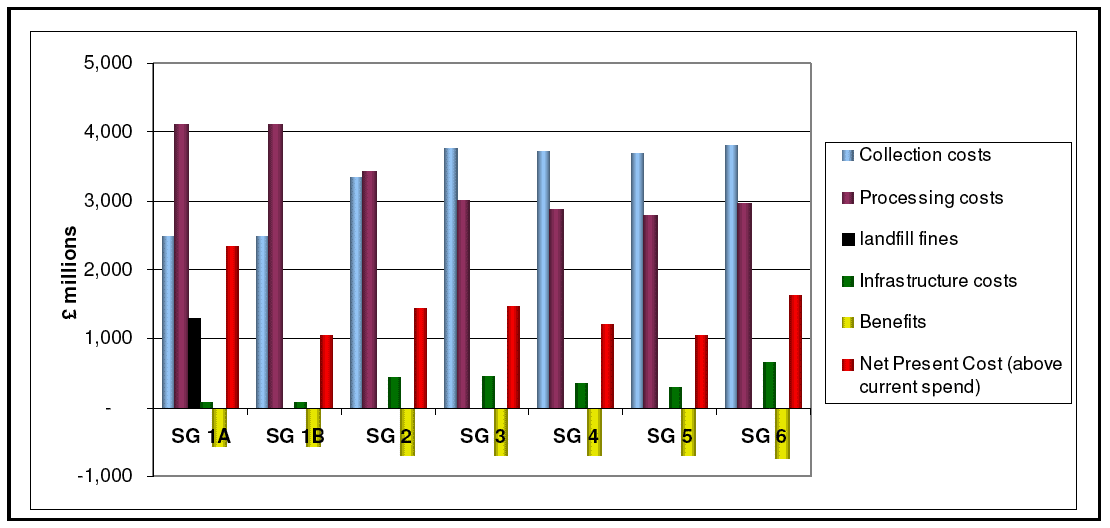
Source: SQW Energy
4.84 It can be seen that although infrastructure investment is significant, by far the most significant factors are collection and processing costs.
4.85 Even in the best case scenarios, the benefits from waste are only capable of marginally off-setting the costs of waste management.
4.86 Of the three 'meet all targets' scenarios (scenario 3 to 5), the Net Present Cost reduces as more source segregation is done. This is due to a combination of reduced infrastructure required to process residual waste and less processing costs as sorting and processing costs are shifted towards the point of waste collection making more efficient use of existing collection infrastructure.
Conclusions
4.87 Regardless of what future waste scenario is considered, the cost of managing Scotland's waste will increase.
4.88 The option of scenario 1a 'doing nothing with landfill fines' is by far the most costly due to landfill penalties. In scenario 1b 'doing nothing without landfill fines' is significantly cheaper, but is still slightly more expensive than the least expensive scenario - Scenario 5 - due primarily to the high levels of source segregation.
4.89 It is more cost effective to meet the EU statutory obligations and avoid landfill fines. To meet EU obligations (only) would require an investment of £434 million in new infrastructure and cost an additional £1,445 million above current spending levels over the waste strategy period (2010 - 2025).
4.90 To meet the more ambitious Scottish Government targets for waste management would require a modest increase in investment over that of EU compliance. For Scenario 3 compared to Scenario 2, this would mean an additional investment of £15 million in new infrastructure and cost an additional £22 million over the waste strategy period (2010 - 2025).
4.91 Increasing source segregation from 50% of TWA to 60% or 65% provide the most cost effective solution. The timing of expenditure to 2025 is essential. By delaying the need for additional infrastructure and the associated expenditure, the Net Present Cost is reduced significantly by increasing source segregation. However, it may have to be considered whether these levels of source segregation are achievable and if so, whether any additional cost would be necessary, e.g. education and public awareness campaigns.
4.92 By accelerating EfW installation (Scenario 6), the result may be to increase competition between EfW and recycling and composting, which may in turn jeopardise recycling and composting targets, i.e. if waste is pulled towards EfW plant to satisfy accelerated EfW installations instead of going to recycling and composting, then this would mean lower recycling and composting rates at the expense of satisfying new EfW capacity.
Contact
Email: Central Enquiries Unit ceu@gov.scotEmail: Central Enquiries Unit ceu@gov.scot
There is a problem
Thanks for your feedback